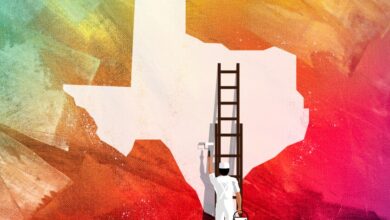The Cost of Connection

[ad_1]
The wife of a whaling captain who regularly works on her husband’s crew, Wilhelm is undaunted by winter temperatures that rarely rise above zero degrees Fahrenheit. She takes in stride the 60-plus days of darkness that descend each November when the sun never rises above the horizon.
Nothing comes easy in Utqiaġvik (formerly known as Barrow), Ala., including the internet service that has to travel through fiber-optic cables buried 12 feet below the ocean floor. It doesn’t come cheap, either. Until 2019, Iḷisaġvik (pronounced il ee sah ga vick) had the most expensive, and slowest, internet service of any tribal college in the country. Many of its students can’t afford internet access at home — which can cost nearly $400 per month — and even now, some users say, the limited bandwidth on campus can lead to dropped connections and sluggish download speeds.
While Wilhelm was able to adjust to remote learning during the pandemic, many of her students couldn’t. Credit enrollment at the nation’s northernmost tribal college slid from 324 students in fall 2019 to 284 in fall 2021.
Meanwhile, 3,200 miles to the south, the outlook is much different for another isolated tribal college. Tohono O’odham Community College, located deep in the Sonoran Desert near the Arizona/Mexico border, serves a nation that spans a section of southwestern Arizona that’s the size of Connecticut.
Like Iḷisaġvik, the college once struggled with sky-high internet costs and sluggish speeds. But after advocates for tribal colleges helped Tohono O’odham (pronounced thaw-haw-gnaw awe-awe-thumb) negotiate better prices and services, credit enrollment at the nation’s southernmost tribal college has grown from 443 in fall 2019 to 764 in fall 2021. The college, based in Sells, Az., now offers free classes, mostly online, to Native students from 64 tribal nations throughout the region.

Lloyd Pikok
But these colleges, which in 1994 were designated as federal land-grant institutions, often operate on shoestrings. They rely more than other minority-serving institutions on federal support because they don’t receive tax dollars from their states or local communities. The federal government only reimburses them for American Indian and Alaska Native students enrolled, not for the approximately 20 percent of students who are non-Native. And since many of their students come from poor families, tribal colleges are constrained in their ability to raise tuition.
All of that means there’s not a lot of money left in the budget to cover the mounting costs of providing decent internet service that both the colleges and their students can afford.
Some tribal colleges in rural regions are charged 20 or 30 times the national average for internet service, said Carrie L. Billy, president of the American Indian Higher Education Consortium, or Aihec. Covid relief money has helped them weather the past two years, she said, but the future is uncertain.
“Once we’re out of this pandemic, are the colleges going to be able to afford the connectivity they now have, or are students going to be able to afford it?” asked Billy, a lawyer who is a member of the Navajo Nation.
“We’re afraid there will be great pipes and fiber lines running through Indian country unused because people won’t be able to afford it due to the exorbitant prices providers are charging.”
But some tribal areas still have no broadband service. And when they do have service, it tends to be slower, with fewer people in tribal communities trained to maintain the technology. At the end of 2019, 79 percent of the population on tribal lands had access to fixed broadband service, but only 47 percent had internet in their homes, according to the Federal Communications Commission. That’s largely because incomes are low and internet rates high.
In Utqiaġvik, households with laptops and reliable home internet service are rare commodities.
“We often hear in our morning meetings that students don’t have access to a computer, and even if they did, they don’t have access to the internet,” said Hal Haynes Jr., who is finishing his first year as dean of students at the Alaska college. “Quite often, they’ve lost the connection, couldn’t log on to Zoom, or the Zoom connection was modest at best.”
He worries about the students from tribal villages the college serves who are trying to complete their GEDs through adult basic-education classes. Without internet at home, they often rely on a library or public school — sometimes that’s the same building — as the village’s only hub to connect.

Lloyd Pikok
When students can’t afford enough bandwidth to have their cameras on during Zoom classes, “only the instructor is visible, and that allows students to not pay attention or be held accountable,” said Andrea Morgana, a tutor and human-resources specialist at the Alaska college. She has to be patient when it takes a long time to open files. In online staff meetings, dropped connections are frequent, and when a blizzard blows through, service for everyone may suddenly halt.
Tribal colleges have long suffered from connectivity challenges. Seventeen states now have laws that prohibit broadband networks that could significantly lower internet rates. The laws, generally backed by Republicans, seek to protect private internet providers from competition. That leaves remote, rural areas in those states relying on local providers with a monopoly on internet service. With so few users spread out over vast areas, often with challenging terrain, service providers often say they can’t afford to lower their rates.
Before Covid hit, Iḷisaġvik’s internet was slogging along at 10 megabits per second, the slowest of any tribal college in the country. In 2019, Quintillian, an Alaska telecommunications company, donated 40 extra megabits to bring it up to 50 megabits per second. That still wasn’t enough to allow video streaming, users said, and service would regularly cut out. Students who were unable to attend remote classes by Zoom dialed up by phone and listened in.
In April 2021, a second donation from Quintillion and an internet-service provider, Alaska Communications, increased the college’s bandwidth to 100 Mbps. That’s plenty of speed for a single family of average users but, for a college, can still result in dropped connections and sluggish download speeds. The boost was welcome, but Aihec pointed out that it was still far short of the 461–megabits–per–second average that tribal colleges nationally have reported in recent years. And it’s far less than even the 2015 national averages Educause reported of 513 megabits per second for all U.S. two-year institutions and 3.5 gigabits per second for four-year institutions.
Fortified with Covid-related Cares Act money from the federal government and donations from Quintillion, Iḷisaġvik doubled its bandwidth, but that doubled the monthly cost of its service, to $95,000, Wilhelm said. Quintillion is covering three quarters of that cost, “which we’re extremely grateful for,” she added.
Even so, the soaring rates the college is paying for internet means that money isn’t available for additional support students badly need to stay enrolled, like math and reading specialists or mental-health counselors, Haynes pointed out.
Wilhelm is concerned, too, that Cares Act funding is limited and future expenses uncertain. “I’m worried that people will get used to the speed, but then we’ll have to revert to 50 megabits.”
Quintillion’s chief revenue officer, Mac McHale, said the contract it signed with Alaska’s tribal college subsidizing a big chunk of its internet costs doesn’t have an end date and that the company has no plans to pull the rug out from under it. The company is working to expand its network in an effort to lower costs, but he said there’s no getting around the fact that serving the isolated location is extremely expensive.
The region the company serves, he said, is “rural on steroids,” with a population of maybe 25,000 to support what, for Quintillion, was a $300-million investment involving lines buried deep below the ocean floor.
Before the pandemic, 90 percent of the college’s students were members of the Tohono O’odham Nation, whose ancestors have lived in the Sonoran Desert for thousands of years. When the pandemic forced the college to move all of its classes online and it faced the possibility of enrollment declines, administrators began looking at ways to recruit more students. Thanks, in part to Covid-19 relief funding, it’s now providing tuition-free courses to students from dozens of tribal nations around the region.

Courtesy of Tohono O’odham Community College
It couldn’t have done that if it hadn’t, with the help of Aihec, negotiated better internet service from its provider at lower rates. Like several other tribal colleges, it’s at the mercy of a single for-profit internet provider that, in the past, had charged sky-high rates for service that college officials said regularly cut out for a day or two. Trying to operate on that service would have been “disastrous” for the college today, its president, Paul M. Robertson, said.
While some might question whether opening the doors to students from more tribal nations could dilute the college’s commitment to its own culture — Tohono O’odham members now represent about 28 percent of students — it brings advantages, said Juana Jose, a founding board member of the college and a cultural liaison. “We have been very isolated being way down in the southern part of Arizona, and now we’re being exposed to other tribal nations,” she said. “We’re learning from each other.”
They’ll continue doing so as some students return to the main campus and a center in Phoenix this spring. The college is planning a campaign to bring about three-dozen students back to dorms for the chance to re-engage with campus traditions like stargazing and storytelling. For many students, though, continuing online is the only realistic option. Seventy percent have dependents, and half work full time.
But like Wilhelm at Iḷisaġvik, college officials at Tohono O’odham wonder what will happen in the coming years when Covid relief money and other emergency measures that have kept both the college and its students afloat run out.
Providing internet services to such sparsely populated regions is expensive, and there’s little assurance that rates won’t be raised again. Maintaining enrollment is likely to require increasing the college’s internet bandwidth to accommodate hybrid classes with in-person and virtual students, said Mario Montes-Helu, dean for sustainability.
“We’re going to continue to reach students wherever they are, and we now have the cameras and microphones and other infrastructure in place in our classrooms to do that,” he said. “But if you imagine four to six classes going on at the same time, with some students present and some remote, I’m pretty sure we’re going to need more bandwidth.”
It’s also lobbying the federal government to provide a permanent, $40-million fund for tribal colleges to help cover their rapidly increasing costs of buying and maintaining internet services, as well as hiring and training technology workers.
Existing federal efforts haven’t gone far enough, critics say. Last year, the U.S. Department of Commerce announced a $980-million grant program to boost broadband connectivity on tribal lands, but it’s geared toward tribal governments, not colleges. No colleges have been awarded grants through that program.
Colleges can compete for another $268-million grant program aimed at helping minority-serving institutions, including tribal colleges, buy broadband access and equipment, as well as technology help. As of last week, no money had been awarded to any recipients through that program.
Back at Iḷisaġvik College, faculty and staff members are meeting regularly with students and making sure they have access to the technology, as well as the academic support, they need to stay connected.
It’s a region that’s accustomed to hardship and to having to wait for good things to come. In January, a handful of students, faculty, and staff members bundled up in fur-lined parkas against the sub-zero cold for the annual ceremony to welcome back the sun. After 60 days of darkness, the neon-orange glow on the horizon was a sign of hope after a long, dark winter. With Covid in retreat and students trickling back on campus, optimism was in the air.
[ad_2]
Source link






